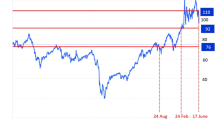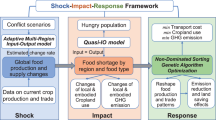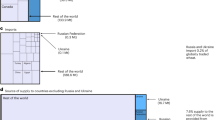Abstract
Crises related to extreme weather events, COVID-19 and the Russia–Ukraine conflict have revealed serious problems in global food (inter)dependency. Here we demonstrate that a transition towards the EAT-Lancet’s planetary health diet in the European Union and the United Kingdom alone would almost compensate for all production deficits from Russia and Ukraine while yielding improvements in blue water use (4.1 Gm3 yr−1), greenhouse gas emissions (0.22 GtCO2e yr−1) and carbon sequestration (17.4 GtCO2e).
This is a preview of subscription content, access via your institution
Access options
Access Nature and 54 other Nature Portfolio journals
Get Nature+, our best-value online-access subscription
$32.99 / 30 days
cancel any time
Subscribe to this journal
Receive 12 digital issues and online access to articles
$119.00 per year
only $9.92 per issue
Buy this article
- Purchase on SpringerLink
- Instant access to full article PDF
Prices may be subject to local taxes which are calculated during checkout


Similar content being viewed by others

Data availability
All secondary, spatially explicit datasets used in this study and an earlier version of the MRIO tables are open access. The FABIO database is freely available via Zenodo (https://doi.org/10.5281/zenodo.2577067), SPAM data can be downloaded from https://www.mapspam.info/ and FBSs are available from FAOSTAT (https://www.fao.org/faostat/en/#data). The source data for Figs. 1 and 2 are available in the Supplementary Information. The MRIO tables and the spatially explicit results from this work are available upon request.
Code availability
The computer code used in this work is available upon request. Code for working with FABIO data in general is available at: https://github.com/fineprint-global/fabio
References
Laborde, D., Herforth, A., Headey, D. & de Pee, S. COVID-19 pandemic leads to greater depth of unaffordability of healthy and nutrient-adequate diets in low- and middle-income countries. Nat. Food 2, 473–475 (2021).
Laborde, D., Martin, W., Swinnen, J. & Vos, R. COVID-19 risks to global food security. Science 369, 500–502 (2020).
Salih, A. A., Baraibar, M., Mwangi, K. K. & Artan, G. Climate change and locust outbreak in East Africa. Nat. Clim. Change 10, 584–585 (2020).
Lang, T. & McKee, M. The reinvasion of Ukraine threatens global food supplies. Brit. Med. J. 376, 0676 (2022).
The Importance of Ukraine and the Russian Federation for Global Agricultural Markets and the Risks Associated with the Current Conflict (FAO, 2022).
Sandström, V. et al. Food system by-products upcycled in livestock and aquaculture feeds can increase global food supply. Nat. Food 3, 729–740 (2022).
Why banning food exports does not work. The Economist (25 May 2022).
Kornher, L. V. B., Joachim & Algieri, B. Speculation Risks in Food Commodity Markets in the Context of the 2022 Price Spikes—Implications for Policy. ZEF Policy Brief 40 (2022).
Safeguarding Food Security and Reinforcing the Resilience of Food Systems (European Commission, 2022).
Pörtner, L. M. et al. We need a food system transformation—in the face of the Russia–Ukraine war, now more than ever. One Earth 5, 470–472 (2022).
Behrens, P. et al. Evaluating the environmental impacts of dietary recommendations. Proc. Natl Acad. Sci. USA 114, 13412–13417 (2017).
Clark, M. A., Springmann, M., Hill, J. & Tilman, D. Multiple health and environmental impacts of foods. Proc. Natl Acad. Sci. USA 116, 23357–23362 (2019).
Sun, Z., Behrens, P., Tukker, A., Bruckner, M. & Scherer, L. Global human consumption threatens key biodiversity areas. Environ. Sci. Technol. https://doi.org/10.1021/acs.est.2c00506 (2022).
Sun, Z., Behrens, P., Tukker, A., Bruckner, M. & Scherer, L. Shared and environmentally just responsibility for global biodiversity loss. Ecol. Econ. 194, 107339 (2022).
Scherer, L., Behrens, P. & Tukker, A. Opportunity for a dietary win–win–win in nutrition, environment, and animal welfare. One Earth 1, 349–360 (2019).
Sun, Z. et al. Dietary change in high-income nations alone can lead to substantial double climate dividend. Nat. Food 3, 29–37 (2022).
Kim, B. F. et al. Country-specific dietary shifts to mitigate climate and water crises. Glob. Environ. Change 62, 101926 (2020).
Mottet, A. et al. Livestock: on our plates or eating at our table? A new analysis of the feed/food debate. Glob. Food Sec. 14, 1–8 (2017).
Erb, K. H. et al. Unexpectedly large impact of forest management and grazing on global vegetation biomass. Nature 553, 73–76 (2018).
Osendarp, S. et al. Act now before Ukraine war plunges millions into malnutrition. Nature 604, 620–624 (2022).
Mustafa, M. A., Mabhaudhi, T. & Massawe, F. Building a resilient and sustainable food system in a changing world—a case for climate-smart and nutrient dense crops. Glob. Food Sec. 28, 100477 (2021).
Springmann, M. & Freund, F. Options for reforming agricultural subsidies from health, climate, and economic perspectives. Nat. Commun. 13, 82 (2022).
Tribaldos, T. & Kortetmäki, T. Just transition principles and criteria for food systems and beyond. Environ. Innov. Soc. Transit. 43, 244–256 (2022).
McGreevy, S. R. et al. Sustainable agrifood systems for a post-growth world. Nat. Sustain. https://doi.org/10.1038/s41893-022-00933-5 (2022).
Agriculture in the United Kingdom 2021 (Department for Environment Food and Rural Affairs, 2022).
Strange, N., Geldmann, J., Burgess, N. D. & Bull, J. W. Policy responses to the Ukraine crisis threaten European biodiversity. Nat. Ecol. Evol. 6, 1048–1049 (2022).
Luckmann, J., Chemnitz, C. & Luckmann, O. Effects of a Change to Fallow land in the EU on the Global Grain Market (Heinrich Böll Foundation, 2022).
Rohr, J. R. et al. Emerging human infectious diseases and the links to global food production. Nat. Sustain. 2, 445–456 (2019).
Van Boeckel Thomas, P. et al. Reducing antimicrobial use in food animals. Science 357, 1350–1352 (2017).
Willett, W. et al. Food in the Anthropocene: the EAT–Lancet Commission on healthy diets from sustainable food systems. Lancet 393, 447–492 (2019).
Semba, R. D. et al. Adoption of the ‘planetary health diet’ has different impacts on countries’ greenhouse gas emissions. Nat. Food 1, 481–484 (2020).
Hayek, M. N., Harwatt, H., Ripple, W. J. & Mueller, N. D. The carbon opportunity cost of animal-sourced food production on land. Nat. Sustain. https://doi.org/10.1038/s41893-020-00603-4 (2020).
Coudard, A., Corbin, E., de Koning, J., Tukker, A. & Mogollón, J. M. Global water and energy losses from consumer avoidable food waste. J. Clean. Prod. 326, 129342 (2021).
Laroche, P. C. S. J., Schulp, C. J. E., Kastner, T. & Verburg, P. H. in Global Environmental Change Vol. 62, 102066 (Elsevier, 2020).
Bruckner, M. et al. FABIO—the construction of the Food and Agriculture Biomass Input–Output Model. Environ. Sci. Technol. 53, 11302–11312 (2019).
Mekonnen, M. & Hoekstra, A. Y. The green, blue and grey water footprint of crops and derived crop products. Hydrol. Earth Syst. Sci. 15, 1577–1600 (2011).
Mekonnen, M. M. & Hoekstra, A. Y. National Water Footprint Accounts: The Green, Blue and Grey Water Footprint of Production and Consumption. Value of Water Research Report Series No. 50 (UNESCO-IHE Institute for Water Education, 2011).
Water Use of Livestock Production Systems and Supply Chains—Guidelines for Assessment (FAO, 2018).
Heffer, P. Assessment of Fertilizer Use by Crop at the Global Level (International Fertilizer Association, 2013).
Spawn, S. A., Sullivan, C. C., Lark, T. J. & Gibbs, H. K. Harmonized global maps of above and belowground biomass carbon density in the year 2010. Sci. Data https://doi.org/10.1038/s41597-020-0444-4 (2020).
Poggio, L. et al. SoilGrids 2.0: producing soil information for the globe with quantified spatial uncertainty. Soil 7, 217–240 (2021).
IFPRI Global Spatially-Disaggregated Crop Production Statistics Data for 2010 Version 1.1. Harvard Dataverse, v.3 (IFPRI, 2019); https://doi.org/10.7910/DVN/PRFF8V
Ramankutty, N., Evan, A. T., Monfreda, C. & Foley, J. A. Farming the planet: 1. Geographic distribution of global agricultural lands in the year 2000. Glob. Biogeochem. Cycles https://doi.org/10.1029/2007GB002952 (2008).
Sloat, L. L. et al. Increasing importance of precipitation variability on global livestock grazing lands. Nat. Clim. Change 8, 214–218 (2018).
Searchinger, T. D., Wirsenius, S., Beringer, T. & Dumas, P. Assessing the efficiency of changes in land use for mitigating climate change. Nature 564, 249–253 (2018).
West, P. C. et al. Trading carbon for food: global comparison of carbon stocks vs. crop yields on agricultural land. Proc. Natl Acad. Sci. USA 107, 19645–19648 (2010).
Johnson, J. A., Runge, C. F., Senauer, B., Foley, J. & Polasky, S. Global agriculture and carbon trade-offs. Proc. Natl Acad. Sci. USA 111, 12342–12347 (2014).
Beck, H. E. et al. Present and future Köppen–Geiger climate classification maps at 1-km resolution. Sci. Data 5, 1–12 (2018).
Acknowledgements
Z.S. was funded by the National Natural Science Foundation of China (grant number 52200222), and Q.Z. was funded by the National Natural Science Foundation of China (grant numbers 42271274 and 51861125101).
Author information
Authors and Affiliations
Contributions
P.B. designed the study. Z.S. performed the analysis. Z.S. and P.B. led the writing, with contributions from L.S. and Q.Z. All authors provided input into the final manuscript.
Corresponding authors
Ethics declarations
Competing interests
The authors declare no competing interests.
Peer review
Peer review information
Nature Food thanks Gidon Eshel, Manfred Lenzen and the other, anonymous, reviewer(s) for their contribution to the peer review of this work.
Additional information
Publisher’s note Springer Nature remains neutral with regard to jurisdictional claims in published maps and institutional affiliations.
Supplementary information
Supplementary Information
Supplementary Figs. 1–13.
Supplementary Tables 1–4
Supplementary Table 1. Food and energy composition of the EAT-Lancet diet, Supplementary Table 2. Per-capita daily food difference between national average diet and EAT-Lancet diet, Supplementary Table 3. Mapping relationship between FABIO sectors and EAT-Lancet diet groups, Supplementary Table 4. Country Code and ISO3 for countries of FABIO, Supplementary Table 5. Percentage of food waste
Source data
Source Data Fig. 1
Crop change due to dietary change in the EU+UK and total production of crops in Ukraine and Russia.
Source Data Fig. 2
Per capita changes in net water consumption, net GHG emissions and net carbon sequestration due to dietary change in EU+UK after replacing all UA+RU crops.
Rights and permissions
Springer Nature or its licensor (e.g. a society or other partner) holds exclusive rights to this article under a publishing agreement with the author(s) or other rightsholder(s); author self-archiving of the accepted manuscript version of this article is solely governed by the terms of such publishing agreement and applicable law.
About this article
Cite this article
Sun, Z., Scherer, L., Zhang, Q. et al. Adoption of plant-based diets across Europe can improve food resilience against the Russia–Ukraine conflict. Nat Food 3, 905–910 (2022). https://doi.org/10.1038/s43016-022-00634-4
Received:
Accepted:
Published:
Issue date:
DOI: https://doi.org/10.1038/s43016-022-00634-4
This article is cited by
-
Scenario analysis of nitrogen surplus typologies in Europe shows that a 20% fertilizer reduction may fall short of 2030 EU Green Deal goals
Nature Food (2025)
-
Transitioning to healthy and sustainable diets has higher environmental and affordability trade-offs for emerging and developing economies
Nature Communications (2025)
-
Does “better” mean “less”? Sustainable meat consumption in the context of natural pasture-raised beef
Agriculture and Human Values (2025)
-
Dissecting the vital role of dietary changes in food security assessment under climate change
Communications Earth & Environment (2024)
-
Quantification of losses in agriculture production in eastern Ukraine due to the Russia-Ukraine war
Communications Earth & Environment (2024)


